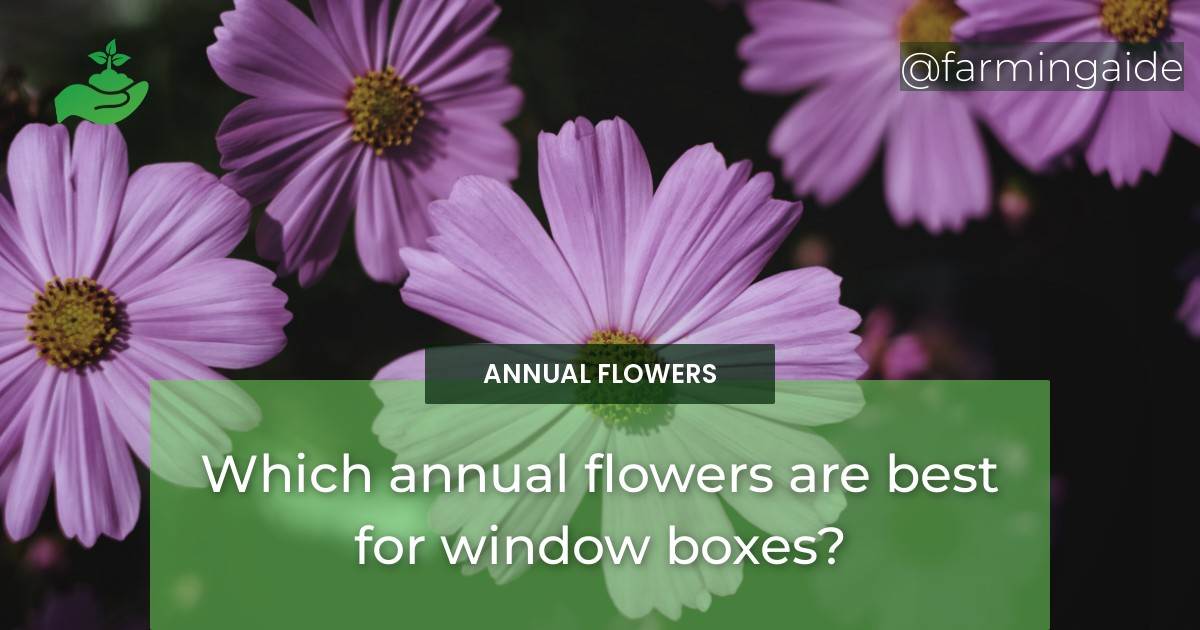When it comes to adding a pop of color and greenery to your windows, annual flowers can be a great choice. These types of flowers typically last for one growing season and come in a variety of colors, shapes, and sizes. However, not all annual flowers are suitable for window boxes as they require a specific growing condition. In this article, we will explore the best annual flowers for window boxes, and tips for creating stunning window box displays.
Best Annual Flowers for Window Boxes
Petunias
Description
Petunias are a popular choice for window boxes as they come in a wide range of colors and bloom profusely throughout the growing season. They can be grown in trailing or upright varieties, making them versatile for window box displays.
Growing Conditions
- Full sun to partial shade
- Well-draining soil
- Regular watering
- Plenty of space to grow
Caring Tips
- Deadhead regularly to promote more blooms
- Fertilize with a balanced fertilizer every two weeks
- Pinch back leggy plants to encourage bushier growth
Geraniums
Description
Geraniums are another classic choice for window boxes. They come in a variety of colors and can be grown in upright or trailing varieties. They have a long blooming season and can add a pop of color to any window display.
Growing Conditions
- Full sun to partial shade
- Well-draining soil
- Regular watering
- Space plants 6-12 inches apart
Caring Tips
- Deadhead regularly to promote more blooms
- Fertilize with a balanced fertilizer every two weeks
- Pinch back leggy plants to encourage bushier growth
Begonias
Description
Begonias come in a variety of colors and sizes, making them a versatile choice for window boxes. They can be grown in upright or trailing varieties and add a pop of color to any window display.
Growing Conditions
- Partial shade to full shade
- Well-draining soil
- Regular watering
- Space plants 6-12 inches apart
Caring Tips
- Deadhead regularly to promote more blooms
- Fertilize with a balanced fertilizer every two weeks
- Avoid overhead watering to prevent fungal diseases
Lobelias
Description
Lobelias have delicate, tiny flowers that come in blue, pink, or white. They are perfect for adding a pop of color and texture to any window box display.
Growing Conditions
- Full sun to partial shade
- Well-draining soil
- Regular watering
- Space plants 3-6 inches apart
Caring Tips
- Deadhead regularly to promote more blooms
- Fertilize with a balanced fertilizer every two weeks
- Pinch back leggy plants to encourage bushier growth
Impatiens
Description
Impatiens are a popular choice for window boxes as they come in a wide range of colors and grow well in shady areas. They have a long blooming season and are great for adding a pop of color to any window display.
Growing Conditions
- Partial shade to full shade
- Well-draining soil
- Regular watering
- Space plants 6-12 inches apart
Caring Tips
- Deadhead regularly to promote more blooms
- Fertilize with a balanced fertilizer every two weeks
- Avoid overhead watering to prevent fungal diseases
What are the best annual flowers for window boxes?
When it comes to annual flower window boxes choices, some great options include petunias, geraniums, lobelia, and marigolds. These colorful blooms will thrive in the confined space and bring life to your windows. Consider mixing different varieties for a vibrant and visually appealing display throughout the year.
Tips for Creating Stunning Window Box Displays
Choose a Color Scheme
When choosing flowers for your window box, it’s important to consider a color scheme. Here are some options:
Harmonious Colors
Choose flowers that are of the same color family. For instance, pink, red, and purple flowers can create a harmonious display.
Contrasting Colors
Choose flowers that are opposite on the color wheel, such as purple and yellow or blue and orange. These colors create a bold and striking display.
Monochromatic Colors
Choose flowers that are of the same color but different shades, such as light pink, medium pink, and dark pink. This creates a subtle and elegant display.
Select Flowers with Different Heights
When choosing flowers for your window box, consider selecting flowers of different heights. This adds dimension and texture to your display.
Tall Flowers
Tall flowers, such as snapdragons or salvia, add height to your window box display.
Medium Flowers
Medium flowers, such as petunias or impatiens, add fullness to your window box display.
Trailing Flowers
Trailing flowers, such as lobelia or bacopa, add a cascading effect to your window box display.
Mix Different Flower Types
Consider mixing different types of flowers in your window box display. Here are some options:
Combining Annuals and Perennials
Combining annuals and perennials in your window box display provides a variety of color and texture. Annuals bloom for one season, while perennials come back year after year.
Incorporating Greenery
Adding greenery, such as ivy or ferns, provides texture and fullness to your window box display.
Proper Plant Spacing and Arrangement
Proper plant spacing and arrangement is important for creating a balanced window box display.
Balancing the Box
When arranging your window box, consider placing taller plants in the center and shorter plants on the sides for a balanced display.
Layering
Layer plants in your window box, starting with the tallest plants in the back and shorter plants in the front.
Filling the Gaps
Fill any gaps in your window box display with greenery or trailing plants.
Watering and Fertilizing
Watering and fertilizing your window box plants is essential for maintaining a healthy and vibrant display.
Watering Frequency
Water your window box plants regularly, especially during hot and dry weather. Avoid getting the foliage wet to prevent fungal diseases.
Fertilizing Schedule
Fertilize your window box plants every two weeks with a balanced fertilizer.
Deadheading and Pruning
Deadhead your window box plants regularly to promote more blooms. Prune leggy plants to encourage bushier growth.


